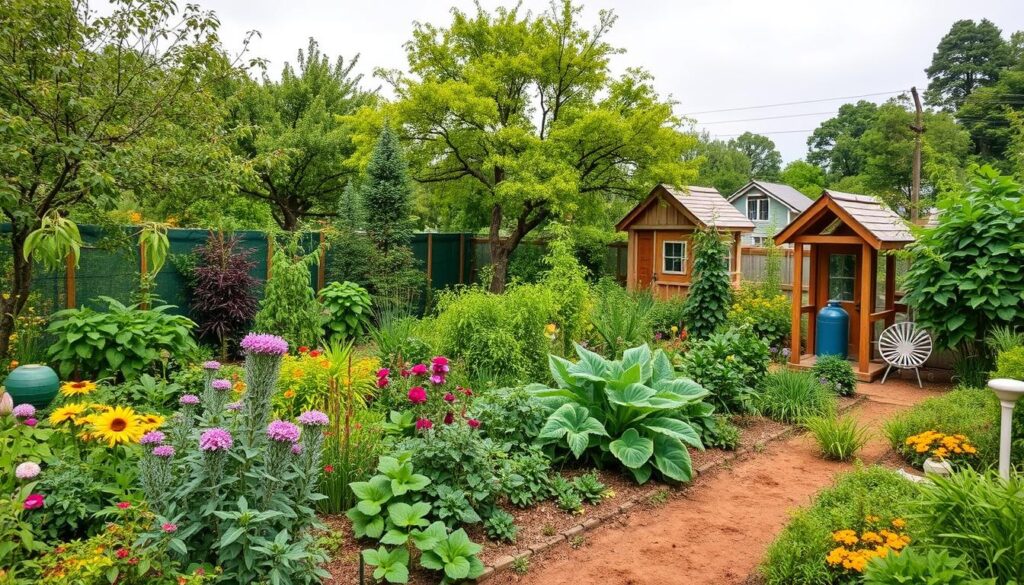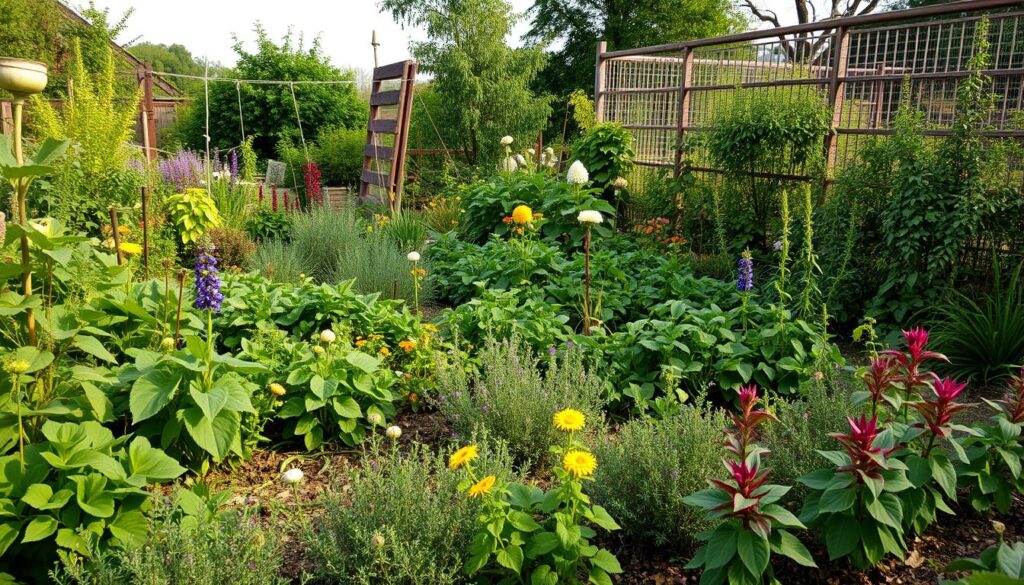A shocking fact is that we’re in the 6th mass extinction, as William Greider pointed out. This crisis is mainly caused by globalization and corporate agendas, leading to more consumption. To counter this, the idea of permaculture economic transition has grown. It focuses on local food, energy, goods, and services, using permaculture funding and sustainable models.
Experts say we need to change our financial and market systems to be regenerative. This can be done with permaculture funding and sustainable models. It’s all about making things sustainable and healthy for our ecosystems.
Key Takeaways
- The current ecological crisis needs a shift to regenerative systems, like permaculture economic transition.
- Permaculture funding strategies and sustainable financing models are key for this transition.
- Localizing food, energy, goods, and services is vital in permaculture economic transition.
- Changing financial and market systems is necessary for a permaculture-based economy.
- Permaculture focuses on sustainability and ecosystem health, leading to a better economy.
- Investing in practices like composting and cover cropping is crucial for soil health and ecosystem productivity.
Understanding Permaculture and Its Principles
Permaculture is a design system that focuses on creating sustainable environments. It’s guided by three ethics: people care, earth care, and fair share. This approach values preserving nature and biodiversity, promoting community, and sharing resources fairly.
Definition of Permaculture
Permaculture was first introduced in 1978. It has grown beyond just farming, becoming a global method for sustainable design. It aims to create spaces that work with nature, needing less outside help over time.
Core Principles of Permaculture
The heart of permaculture is caring for the environment and building strong communities. It also focuses on sharing resources fairly. Designing with permaculture involves understanding systems, analyzing connections, and using methods like no-till farming and composting.
Importance of Sustainability
Sustainability is key in permaculture. It helps create systems that can regenerate themselves. Funding, grants, and crowdfunding support sustainable farming. By using permaculture, farmers can lessen their environmental footprint and boost their economic health.
Permaculture can change how we grow food and interact with nature. By applying its principles, we can build a more sustainable world. Support for permaculture through funding and grants can help achieve this goal, benefiting both the environment and society.
The Need for Economic Transition
The current economic system focuses on making profits, ignoring the environment and people’s well-being. This has led to big problems and the need for a change. Experts say we must cut down on waste and use of resources by a lot to avoid major disasters.
They suggest we need to reduce our carbon and ecological footprints by 80% in the next 20 years. To do this, investment options for permaculture initiatives and innovative funding approaches for permaculture are key. Some important steps for changing our economy include:
- Mobilizing local and regional social and financial capital
- Developing supportive and regenerative ‘enterprising ecosystems’
- Facilitating horizontal connections among diverse actors through convergence networks
By using these strategies and looking into investment options for permaculture initiatives and innovative funding approaches for permaculture, we can build a fairer and greener economy. This change is vital for a sustainable future and to fix the social and economic gaps caused by old systems.

| Strategy | Description |
|---|---|
| Mobilizing local and regional social and financial capital | Involving community members with skills and financial resources to build local accountability and attract external investment |
| Developing supportive and regenerative ‘enterprising ecosystems’ | Creating a network of co-working spaces, training programs, and local authorities to support new ventures |
| Facilitating horizontal connections among diverse actors through convergence networks | Enabling innovation and solidarity through connections among diverse actors |
Benefits of a Permaculture Economic System
Permaculture economic systems bring many benefits. They improve local food systems, help conserve biodiversity, and make communities stronger. By using permaculture, people help create a more sustainable economy. Fundraising for sustainable agriculture and getting financial support for regenerative practices are key to these systems.
One big plus of permaculture is how it boosts local food systems. This happens through community gardens, urban farms, and backing local farmers. By supporting local food systems, we can cut down our carbon footprint and support better farming.
Permaculture also helps with biodiversity by using many plant species. This keeps ecosystems healthy and balanced. Experts say urban permaculture is vital for saving biodiversity and green urban planning.
| Benefits of Permaculture Economic Systems | Description |
|---|---|
| Enhanced Local Food Systems | Promotes community gardens, urban agriculture, and support for local farmers |
| Support for Biodiversity Conservation | Promotes the use of diverse and native plant species to maintain ecosystem health |
| Strengthened Community Resilience | Encourages community engagement, cooperation, and mutual support |
Key Elements of Permaculture Economics
Permaculture economics focuses on managing resources well and using closed-loop systems. It also emphasizes cooperative enterprises. These elements help create sustainable economic models. They are supported by permaculture funding strategies and sustainable financing models.
Some key features of permaculture economics include:
- Resource management: This involves managing resources in a way that minimizes waste and maximizes efficiency.
- Closed-loop systems: These systems aim to recycle and reuse resources, reducing the need for external inputs.
- Cooperative enterprises: These enterprises are owned and controlled by their members, who work together to achieve common goals.
Permaculture funding strategies and sustainable financing models are crucial. They help support these elements. By using crowdfunding and community-supported agriculture, permaculture projects can get the funding they need.

By adopting permaculture economics, communities can build sustainable economic systems. These systems focus on people and the planet. This approach helps solve problems like environmental damage and social inequality.
| Element | Description |
|---|---|
| Resource Management | Managing resources to minimize waste and maximize efficiency |
| Closed-Loop Systems | Recycling and reusing resources to reduce external inputs |
| Cooperative Enterprises | Member-owned and controlled enterprises that work together to achieve common goals |
Designing a Permaculture-Based Economy
Creating a permaculture-based economy means thinking about how to use land and resources wisely. It also involves working together as a community. This effort can be boosted by regenerative agriculture funding and grants for permaculture projects. These resources help build strong, sustainable economic systems.
To design a permaculture-based economy, you need to know your local ecosystem and community well. You must create a holistic plan that considers social, economic, and environmental factors. Key points to think about include:
- Landscape layout and design: This means making a landscape that is both sustainable and productive, meeting community needs.
- Integrating renewable resources: This includes using energy from the sun and wind, and farming in a way that’s good for the planet.
- Holistic community engagement: This means getting the community involved in planning and decision-making. This way, the economy meets their needs and priorities.
By focusing on these areas and looking for grant opportunities for permaculture projects, communities can build strong, sustainable economies. These economies help both people and the planet.
| Aspect | Considerations |
|---|---|
| Landscape Layout and Design | Sustainable and productive landscape, meets community needs |
| Integrating Renewable Resources | Renewable energy sources, sustainable agriculture practices |
| Holistic Community Engagement | Community involvement in design and decision-making process |
Case Studies of Successful Transitions
Across the globe, many places have moved to permaculture-based economies. These shifts show us how to succeed. They often use crowdfunding for sustainable farming and investment options for permaculture initiatives to grow.
Examples from Around the World
Some examples include:
- Community-supported agriculture programs in the United States
- Permaculture cooperatives in Europe
- Sustainable farming initiatives in Australia
These examples teach us the role of investment options for permaculture initiatives in growing sustainable farming.
Lessons Learned from Implementations
The table below shares key lessons from these examples:
| Case Study | Lessons Learned |
|---|---|
| Community-supported agriculture programs | Importance of community engagement and crowdfunding for sustainable farming |
| Permaculture cooperatives | Value of cooperative ownership and investment options for permaculture initiatives |
| Sustainable farming initiatives | Need for diversified revenue streams and investment options for permaculture initiatives |

Policy Implications for Economic Transition
The world is moving towards a sustainable economy, and policy is key. New ways to fund permaculture and support sustainable farming are vital. Governments, NGOs, and private groups must work together to help.
Some important policy steps include:
- Offering incentives like tax breaks or subsidies for permaculture projects
- Creating rules that favor eco-friendly farming and cut down on harmful chemicals
- Backing education and training in permaculture to spread knowledge
A table below shows the good that permaculture policies can do:
| Policy Implication | Benefit |
|---|---|
| Incentives for sustainable practices | Encourages more permaculture use |
| Regulations promoting eco-friendly agriculture | Less pollution and better health |
| Education and training programs | More people know and can do permaculture |
By taking these steps, we can build a sustainable economy. This economy cares for both people and the planet. Funding for sustainable farming and new ways to fund permaculture are essential for a bright future.
Education and Awareness Programs
Education and awareness programs are key to a successful shift to a permaculture-based economy. They give communities and individuals the tools they need for permaculture. This includes financial support for regenerative practices and permaculture funding strategies.
It’s important to teach communities about permaculture’s value and benefits. Workshops, training, and online resources can help. Some main parts of these programs are:
- Community outreach and engagement
- Training programs for practitioners
- Online resources and workshops
Supporting financial support for regenerative practices and permaculture funding strategies helps keep permaculture going. This makes our communities stronger and more eco-friendly.

Education and awareness are crucial for a permaculture-based economy. It’s inclusive, sustainable, and fair. By sharing knowledge and resources, we can create a brighter future for everyone.
| Program | Description |
|---|---|
| Community Education | Raising awareness about permaculture and its benefits |
| Training Programs | Providing skills and knowledge for permaculture practitioners |
| Online Resources | Offering accessible information and workshops on permaculture |
Overcoming Challenges in Transition
Starting a permaculture-based economy is tough, but knowing the hurdles helps. One big problem is getting money, which is where sustainable financing models help. These models focus on long-term success, perfect for permaculture projects.
Finding investment options for permaculture initiatives is another hurdle. This includes renewable energy, green farming, and eco-friendly buildings. By looking into these areas, we can help permaculture grow.
Here are some ways to tackle these challenges:
- Building a network of people who share your vision
- Creating business plans that focus on sustainability and helping others
- Looking for new ways to fund permaculture projects
By using these strategies and finding sustainable financing models and investment options for permaculture initiatives, we can beat the odds. We can build a better, greener future.
Measuring Success in Permaculture Transitions
It’s key to measure success in permaculture to see if it’s working. We need to set goals, listen to the community, and aim for long-term success. Regenerative agriculture funding is vital for these projects to grow.
Here are some things to look at when measuring success:
- Environmental impact: like less greenhouse gas, better soil, and more biodiversity
- Social impact: more community involvement, education, and jobs
- Economic impact: more local food, jobs, and economic growth

Grant opportunities for permaculture projects help fund these efforts. With the right funding, we can make sure permaculture works well for a long time.
| Factor | Metrics for Evaluation |
|---|---|
| Environmental Impact | Greenhouse gas emissions, soil health, biodiversity conservation |
| Social Impact | Community engagement, education, economic benefits |
| Economic Impact | Local food production, job creation, local economic stimulation |
Future Directions for Permaculture Economics
The world faces big challenges like environmental damage and social inequality. Permaculture economics offers a hopeful solution. It uses innovative funding approaches for permaculture to support sustainable farming. This way, people and communities can help farms grow in a green way.
One great method is crowdfunding for sustainable farming. It lets farmers get money and help from their neighbors. This helps farms grow strong and healthy.
The future of permaculture economics looks bright. More people see its value in making a better world. Key trends include:
- Regenerative agriculture and soil conservation
- Agroforestry and perennial crop systems
- Community-supported agriculture and cooperative enterprises
Supporting these efforts and finding new ways to fund them is crucial. This will help build a fair and green food system. As permaculture grows, focusing on crowdfunding for sustainable farming and innovative funding approaches for permaculture is key. This will ensure a bright future for everyone.
Getting Involved in the Movement
Now that we’ve looked at the benefits of permaculture, it’s time to talk about how you can join in. Whether you’re an individual wanting to help or a community looking to change, there are many ways to contribute.
Opportunities for Individuals
Individuals can make a big difference in the permaculture movement. You can support projects by investing in local businesses or helping with crowdfunding. There are also ways to fund bigger sustainable projects.
Joining Local Permaculture Groups
Connecting with others in your area is key. Joining local permaculture groups lets you share knowledge, work together, and start projects in your neighborhood. This can turn your area into a green, thriving place.
Participating in Workshops and Events
Workshops and events are great for learning and meeting others. They offer everything from basic courses to advanced design sessions. These places can inspire and help you make a real difference.

